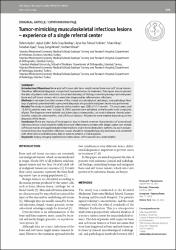| dc.contributor.author | Aydın, Özlem | |
| dc.contributor.author | Çelik, Aykut | |
| dc.contributor.author | Batıbay, Sefa Giray | |
| dc.contributor.author | Toksöz Yıldırım, Ayşe Nur | |
| dc.contributor.author | Okay, Erhan | |
| dc.contributor.author | Ayaz, Tunahan | |
| dc.contributor.author | Zenginkinet, Tülay | |
| dc.contributor.author | Özkan, Korhan | |
| dc.date.accessioned | 2022-07-26T06:25:44Z | |
| dc.date.available | 2022-07-26T06:25:44Z | |
| dc.date.issued | 2022 | en_US |
| dc.identifier.citation | Aydın, Ö., Çelik, A., Batıbay, S. G.,Toksöz Yıldırım, A. N., Okay, E., Ayaz, T. ... Özkan, K. (2022). Tumor-mimicking musculoskeletal infectious lesions – experience of a single referral center. Srpski Arhiv za Celokupno Lekarstvo, 150(5-6), 295-301. https://doi.org/10.2298/SARH210916050A | en_US |
| dc.identifier.issn | 0370-8179 | |
| dc.identifier.uri | https://doi.org/10.2298/SARH210916050A | |
| dc.identifier.uri | https://hdl.handle.net/20.500.12511/9608 | |
| dc.description.abstract | Introduction/Objectives Bone and soft tissue infections might mimic bone and soft tissue tumors. Therefore, differential diagnosis is important to prevent errors in treatment. This report aims to present the data of patients with indistinct clinical and radiological findings mimicking benign and malignant bone and soft tissue tumors, which were later diagnosed as inflammatory infections. Methods A retrospective chart review of the clinical, microbiological, radiologic, and pathologic findings of patients presented with a presumed diagnosis of a possible malignant lesion was performed. Results The study included 21 patients with a median age (IQR) of 37 (1 month – 72 years) years, and 13 (61%) patients were men. In total, 16 (76%) patients were admitted to the hospital with complaints of pain. The diagnoses were hydatid cyst, tuberculous osteomyelitis, cat-scratch disease, chronic osteo-myelitis, subacute osteomyelitis, and soft tissue abscess. All patients were treated depending on the diagnosis of the lesion. Conclusion There are chances of misdiagnosis due to shared common characteristics of tumoral and infectious lesions which might be mildly increased inflammatory markers with deeply seated non-mobile soft tissue masses and aggressive periosteal reactions and/or bone destruction patterns. So, each pseudo-tumoral lesion due to possible infectious causes should be histopathologically examined and correlated with other clinical and laboratory data in order to achieve a final diagnosis. | en_US |
| dc.language.iso | eng | en_US |
| dc.publisher | Serbia Medical Society | en_US |
| dc.rights | info:eu-repo/semantics/embargoedAccess | en_US |
| dc.subject | Biopsy | en_US |
| dc.subject | Hydatid Cyst | en_US |
| dc.subject | Imaging | en_US |
| dc.subject | Osteomyelitis | en_US |
| dc.subject | Soft Tissue Abscess | en_US |
| dc.subject | Tuberculosis | en_US |
| dc.title | Tumor-mimicking musculoskeletal infectious lesions – experience of a single referral center | en_US |
| dc.type | article | en_US |
| dc.relation.ispartof | Srpski Arhiv za Celokupno Lekarstvo | en_US |
| dc.department | İstanbul Medipol Üniversitesi, Tıp Fakültesi, Cerrahi Tıp Bilimleri Bölümü, Ortopedi ve Travmatoloji Ana Bilim Dalı | en_US |
| dc.authorid | 0000-0002-6226-6651 | en_US |
| dc.identifier.volume | 150 | en_US |
| dc.identifier.issue | 5-6 | en_US |
| dc.identifier.startpage | 295 | en_US |
| dc.identifier.endpage | 301 | en_US |
| dc.relation.publicationcategory | Makale - Uluslararası Hakemli Dergi - Kurum Öğretim Elemanı | en_US |
| dc.identifier.doi | 10.2298/SARH210916050A | en_US |
| dc.institutionauthor | Batibay, Sefa Giray | |
| dc.identifier.wosquality | Q4 | en_US |
| dc.identifier.wos | 000830701100007 | en_US |
| dc.identifier.scopus | 2-s2.0-85133680571 | en_US |
| dc.identifier.scopusquality | Q4 | en_US |


















